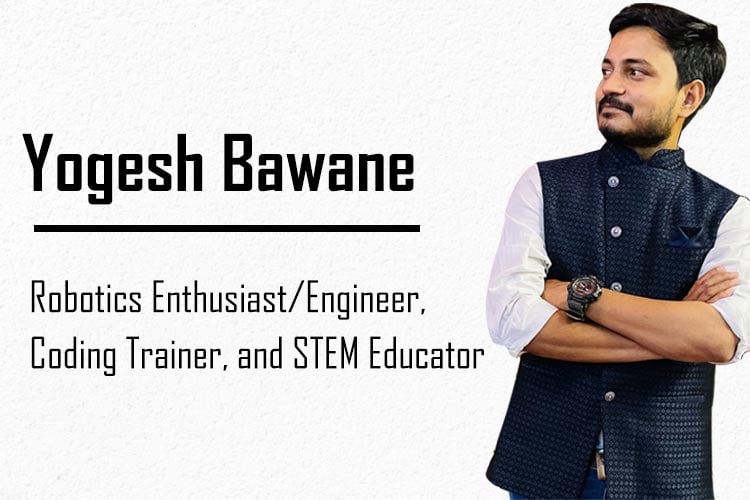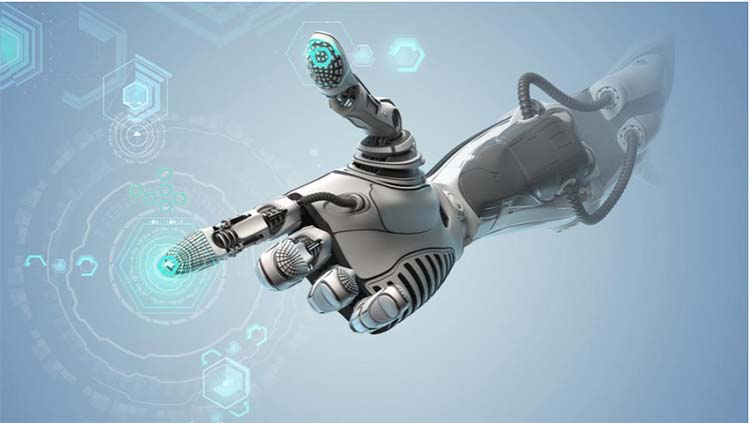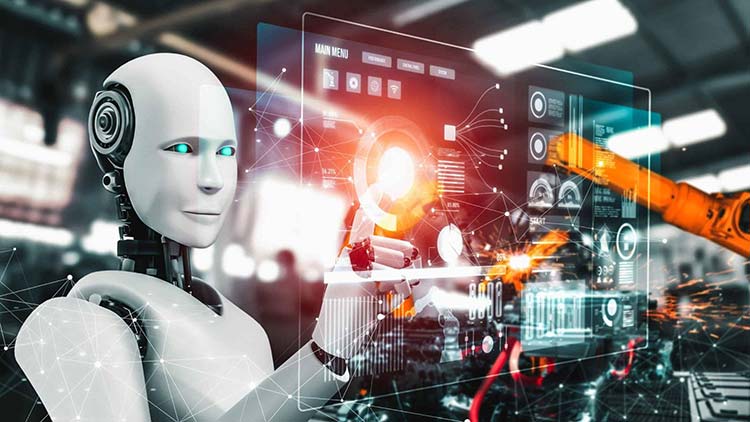
For the past few years, developing countries like India are going through a lot of alterations in terms of technology and one such development in this world is robotics. Now, with a huge improvement in science and technology, robotics is appearing in the industrial space very quickly. Experts opine that robotics is very useful for industrial automation that includes assembly, manufacturing, and packaging. Amid all the positive vibes, the sector is also dealing with a lot of challenges like loss of human workforce as these machines have the potential to perform repetitive tasks. Then, there are security threats like the drone attacks of Kashmir. When it comes to growth and manufacturing of robotics, India is still way behind many countries. In this regard, we spoke to Yogesh Bawane, a robotics enthusiast/engineer, coding trainer, and a STEM educator about the current challenges India is facing in robotics manufacturing and growth, what the industry needs from the government, and in the coming five years where will India’s robotics industry will move forward.
Q. Can you please highlight how your journey as a robotics enthusiast and an engineer has been so far? What are your specialties in the field of technology?
My interest in robotics started when I saw students competing in robotics competitions during my Engineering days. The sight of robots moving and functioning was fascinating to me, and I knew that I wanted to be a part of it. From that day, I began to explore the field of robotics more deeply. I started to learn about electronics, programming, and mechanics, and I began to build my own robots. Through trial and error, I learned a great deal about how to design and build robots that were efficient and effective. Participating in various competitions helped me to refine my skills and gain more practical experience in the field of robotics.
During my journey, I noticed that there was a gap between the education system and the real world. Many students were learning theory but were unable to apply it practically. So, I started to teach robotics to kids so that they could learn things more practically. I believe that teaching is the best way to learn, and teaching robotics to kids was a great way for me to continue learning while sharing my knowledge with others. Now, robotics is my passion, and I am following it full-time. I don't feel like working in a 9-5 job because I love what I do. My specialties mainly include teaching and building projects related to IoT, Electronics, and Machine Learning. I believe that robotics has a bright future and I am excited to be a part of it.
Q. As a market expert and as an engineer what do you think are the current biggest hurdles India is facing in the robotics industry and growth when compared to other countries? What must the nation do to become globally competitive?
As I am working in the Robotics and STEM education industry, I believe that India is facing several challenges in the robotics industry. One of the most significant hurdles is the lack of skilled manpower. The demand for skilled engineers and technicians in the field of robotics is high, but the supply is limited. This shortage of skilled manpower is hindering the growth of the robotics industry in India.
Another challenge is the lack of funding and investment in the robotics industry. Many investors in India are still unaware of the potential of the robotics industry, and as a result, they are hesitant to invest in it. This lack of funding and investment is limiting the growth of the robotics industry in India. Additionally, there is a lack of awareness among the general public about the benefits of robotics. Many people in India are still unaware of the applications and benefits of robotics in various fields, such as healthcare, manufacturing, and agriculture. This lack of awareness is hindering the adoption of robotics in India.
To become globally competitive in the field of robotics, our government has taken great initiatives like building more than 10,000 Atal Tinkering Lab schools. However, the execution on the ground is not satisfactory. At some places, these labs are not even being used. In my opinion, we have everything we need, but we lack skilled personnel who can execute the initiatives and teach robotics on a daily basis like any other regular subject. It is crucial to have teachers who are trained and skilled in robotics to help students understand the subject better.

Q. Do you think the government is doing enough to boost India's robotics manufacturing? What are your expectations from the government?
As an engineer and a market expert, I believe that the government can do more to boost India's robotics manufacturing. While the government has taken several initiatives to promote the growth of the robotics industry, more needs to be done to create a favorable environment for the manufacturing of robotics in India. It is encouraging to know that the Union Electronics and information technology ministry is planning to boost robotics and manufacturing and export of drones under the Production Linked Incentive (PLI) scheme. According to officials aware of the matter, the PLI scheme aims to create production worth $2 billion per player for drones and robotics. The scheme will provide overall incentives of $150 million to players in the industry.
This is a significant step towards promoting the growth of the robotics industry in India. With the emerging market for drones and robotics, this scheme will help India capture a space in it on the global scale. This is a positive sign for the industry and will encourage more companies to invest in robotics manufacturing in India. If executed well, the PLI scheme could help India become a major player in the global robotics manufacturing industry. This will not only lead to job creation and economic growth but will also position India as a leading player in the global technology landscape. In addition to the PLI scheme for drones and robotics, my expectation from the government is to ensure that the scheme is executed efficiently and effectively. It is important to ensure that the benefits of the scheme reach the right candidates in a timely manner. The government needs to focus on identifying and supporting the right companies and individuals who are genuinely interested in promoting the growth of the robotics industry in India.
Q. What are some of your unique and exceptional work in the field of robotics? Can you please share a case study? Also if you can kindly mention some of the unique projects or other activities you are doing in robotics?
One of my exceptional projects was the development of an Industry 4.0 system for monitoring furnace temperature over the Internet. I collected data from the furnace and used it to build a predictive maintenance system for the galvanising wire. This system helped to reduce downtime and increase efficiency in the production process. Another project that I'm particularly proud of is a home automation system that I built using IoT technologies. The system allows users to control various aspects of their home, such as lighting, temperature, and security, through a mobile app. I used Arduino IDE and ESP32 Board to connect various sensors and devices to the internet and monitor the system remotely.
I am also proud of the fact that I have developed various monitoring systems based on IoT, which allows one to monitor all the industry data at one place. This has helped to improve the overall efficiency and productivity of the industries where these systems have been implemented. In addition, I am actively sharing my knowledge and experience with others through my YouTube channel. I upload videos related to IoT, coding, electronics, machine learning, and other topics in order to promote learning and awareness in these fields.
Currently, I am involved in building cutting-edge technology curricula for kids at RoboCHAMPS. This program is designed for students from grade 1 to grade 12 and aims to provide them with a strong foundation in the field of robotics and technology. By teaching children at a young age, we can help to inspire and empower the next generation of engineers, innovators, and problem-solvers. I am very excited about this initiative and believe that it will have a significant impact on the future of robotics and technology in India.
Q. How long is your association with RoboCHAMPS? What are the work and activities they do in this field?
I have been associated with RoboCHAMPS for more than a year. At RoboCHAMPS, we focus on teaching the most advanced technology to kids in a gamified way. Our aim is to make learning technology fun and engaging for kids. We teach robotics, artificial intelligence, IoT, electronics, and STEM to students from kindergarten to 12th grade. Our classes are conducted online and are one-to-one, which helps us cater to students from various countries such as the Middle East, Vietnam, Indonesia, UK, USA, and more. Our curriculum is designed in a way that helps students learn while having fun. Also, they will learn about how to solve real life problems . We believe that by teaching these technologies to kids, we are preparing them for the future where technology will play a significant role in all aspects of life.

Q. Robotics and automation are now playing an important role in industry 4.0. Which country do you think is leading in this aspect? Do you also think this will increase human unemployment?
There are a few countries that are leading the way in the field of robotics and automation for Industry 4.0, including Germany, Japan, and the United States. Germany has been at the forefront of Industry 4.0, with its "Industrie 4.0" initiative that promotes the integration of advanced technologies like IoT, big data, and AI into manufacturing processes.
Japan is also known for its advanced robotics technology, particularly in the areas of service robots and automation. The United States has a strong focus on AI, with many of the top AI companies and research institutions located there. As for the question of whether robotics and automation will increase human unemployment, it's a complex issue. While automation may eliminate some jobs, it also has the potential to create new ones, particularly in the field of robotics itself. Additionally, automation can increase productivity and efficiency, leading to economic growth and potentially more job opportunities. As automation becomes more prevalent, it will create new job opportunities in areas such as machine maintenance, programming, and operations. However, it is important for individuals to upskill themselves and learn the necessary technical and analytical skills to stay relevant in the job market.
Q. Going forward, where and how do you think robotics will dominate manufacturing in India in the coming few years? As an expert, what are your plans for this industry in the coming years?
I believe that in the coming years, robotics will play a crucial role in the manufacturing sector in India. With the adoption of Industry 4.0 and automation, we will see an increased use of robots for tasks such as assembly, welding, and material handling. This will lead to increased efficiency, productivity, and cost savings for manufacturing companies.
As an expert in robotics, my plans for the industry in the coming years involve creating industry-specific curricula that focus on solving real-life problems using technology.
I strongly believe that students should be equipped with 21st-century skills to prepare them for future jobs. With the growing demand for skilled professionals in the field of robotics and automation, I aim to contribute to this industry by preparing students with the skills necessary to thrive in this field. By creating customized curricula that cater to the needs of different industries, we can ensure that students are job-ready and can effectively apply their skills to solve industry-specific problems. In addition, I will continue to work with organizations such as RoboCHAMPS to promote the adoption of robotics and automation in education and industry. By doing so, we can ensure that India is at the forefront of this technological revolution and that our youth is prepared for the jobs of the future.

